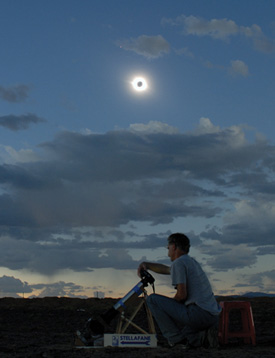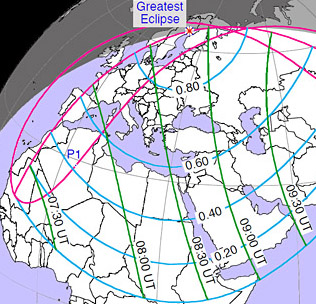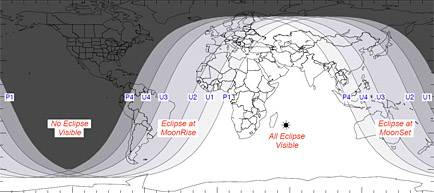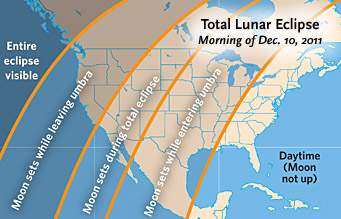After three consecutive years of enjoying time in the Moon's shadow, eclipse-chasers must go through withdrawal during 2011 because no total solar eclipses occur. However, the year kicks off with a deep partial solar eclipse that favors northern Europe, and a pair of total lunar eclipses come later on.

Few events in nature offer the drama and spectacle of a total solar eclipse, as demonstrated by this one seen over China on August 1, 2008.
S&T: Dennis di Cicco
A solar eclipse can only happen at new Moon, when the lunar disk passes directly between us and the Sun. Conversely, a lunar eclipse occurs during full Moon, when our satellite passes through Earth's shadow. These alignments don't occur at every new and full Moon because the lunar orbit is tipped about 5° to Earth's orbital plane — only occasionally do the Sun, Earth, and Moon line up exactly enough for an eclipse to occur.
Three types of lunar eclipse are possible (total, partial, and penumbral) depending on how deep the full Moon plunges into or near the umbra, our planet's dark, central shadow. If it goes all the way in, we see a total lunar eclipse that's preceded and followed by partial phases. If the Moon skims part way into the umbra, only the partial phases occur. And if its disk passes just outside the umbra, it still encounters the weak penumbral shadow cast by Earth. (Oddly, four penumbral eclipses occurred last year.) Fortunately, no matter which type occurs, a lunar eclipse is observable anywhere on Earth where the Moon is above the horizon.
Because the Moon casts a smaller shadow than Earth does, eclipses of the Sun require observers to be in the right place at the right time. If the Moon completely hides the Sun, even for a moment, the eclipse is considered total. With its brilliant disk completely covered, the Sun's ghostly white outer atmosphere is momentarily revealed for anywhere from seconds to several minutes. However, this totality can only be viewed a narrow track or path on Earth's surface. Outside that path, about half the world is able to watch a partial eclipse as the Moon obscures a portion of the Sun.
Occasionally the Moon passes directly in front of the Sun but doesn't completely cover it. This odd-sounding situation is an annular eclipse, so-called because you can see a ring, or annulus, of sunlight surrounding the lunar disk. But an annular's path is likewise narrow, and outside of it observers see only a partial cover-up. No annular eclipses occur in 2011.
Interestingly, up to seven eclipses can take place in one year, and the last time that happened was 1982. The fewest possible is four, as was the case last year. Yet any given year can have only two "central" (annular or total ) solar eclipses, and again there was one of each in 2010.
Below are brief descriptions of this year's eclipses of the Sun and Moon. You'll find more details on this website and in Sky & Telescope magazine as the date of each draws near. Times are in Universal Time (UT) except as noted.

January 4th's partial solar eclipse favors viewers in northern Europe, western Asia, and northern Africa. Blue lines show how much of the Sun's diameter is covered; green lines give Universal Time for mid-eclipse. Click on the image for a global view.
Fred Espenak
January 4: Partial Solar Eclipse
The year kicks off with a deep partial eclipse of the Sun that favors Europe (especially Scandinavia), northern Africa, and western Asia. Unfortunately, none of this event is visible from North America.
Here's a sampling of cities offering good views, followed by the Universal Time of mid-eclipse at that location and how much of the Sun's disk is covered: Madrid (7:52, 47%), Paris (8:09, 65%), London (8:12, 67%), Stockholm (8:42, 79%), and Moscow (9:04, 75%). To see this eclipse at its maximum, you need to be in northeastern Sweden at 8:50:35 UT.
Skywatchers as far south as Nigeria and as far east as Mongolia have a chance to see the Moon's silhouette take at least a small bite out of the Sun. Click here for more details.
June 1: Partial Solar Eclipse
A sequence of three syzygies over one month's time begins with a partial solar eclipse that falls across some of the world's least inhabited landmasses: Siberia, northern Canada, and Greenland. Mid-eclipse occurs at 21:17 UT. From the North Pole you'd see about one third of the Sun's disk covered by the Moon. Residents of Reykjavik, Iceland, can look forward to seeing 35% of the Sun's disk hidden near sunset. Alaskans north of Fairbanks and residents of northern New Brunswick and Nova Scotia have a chance to see slight divots in the Sun around midday and near sunset, respectively

The long-lasting total lunar eclipse on June 15, 2011, favors skywatchers in the Eastern Hemisphere.
Fred Espenak
June 15: Total Lunar Eclipse
Two weeks after a New Moon and a corresponding partial solar eclipse, the full Moon plunges deeply through Earth's umbra in the first of this year's total lunar eclipses. Totality lasts a whopping 100 minutes — nearly 40 minutes longer than the well-observed lunar eclipse in December 2010. The Moon is completely covered from 19:22 to 21:02 UT, and the partial phases begin one hour beforehand and end an hour afterward. To the chagrin of North American viewers, this timing places the June 15th event almost entirely over the Eastern Hemisphere, though viewers in eastern South America can see its later stages.
July 1: Partial Solar Eclipse
The third event in this year's three-eclipse trifecta is a partial solar eclipse that few people, if any, can see. The path crosses the Antarctic Ocean well south of Africa, from which the Moon's indentation on the Sun's disk will be barely noticeable when mid-eclipse occurs at 8:38 UT.
November 25: Partial Solar Eclipse
Although the Moon takes a bigger bite of the Sun during November's event, the far-southern path is no better placed for viewing. Researchers at the South Pole can see about 75% of the Sun's diameter covered when the event peaks there at 6:30 UT. Slight partial phases can be seen from the southern tip of Africa just after sunrise and from Tasmania and southernmost New Zealand just before sunset.

Skywatchers in western North America have the best seats for the total lunar eclipse on December 10, 2011.
Sky & Telescope illustration
December 10: Total Lunar Eclipse
Year's end offers the finest spectacle of 2011 for skywatchers in the western U.S. and Canada: a total lunar eclipse before dawn. Totality extends from 6:06 to 6:57 a.m. PST (14:06 to 14:57 UT). The partial phase begins at 4:46 a.m. PST, when the Moon's leading edge enters the dark umbra of Earth's shadow, and the final bit of the Moon's disk exits the umbra at 8:18 a.m. But by then the Moon will have set (and the Sun risen) everywhere east and south of British Columbia. The entire eclipse is visible in the Pacific Ocean and much of Asia.
Looking ahead to next year, 2012 will in some sense represent a reversal of fortunes from 2011. There'll be two central solar eclipses: an annular on May 20th (visible from the Pacific and western U.S.) and a total on November 13th (northeast Australia and South Pacific). But lunar eclipses will be limited to a partial event on June 28th and a barely-there penumbral eclipse on November 28th. Click here for details.
 0
0
Comments
You must be logged in to post a comment.